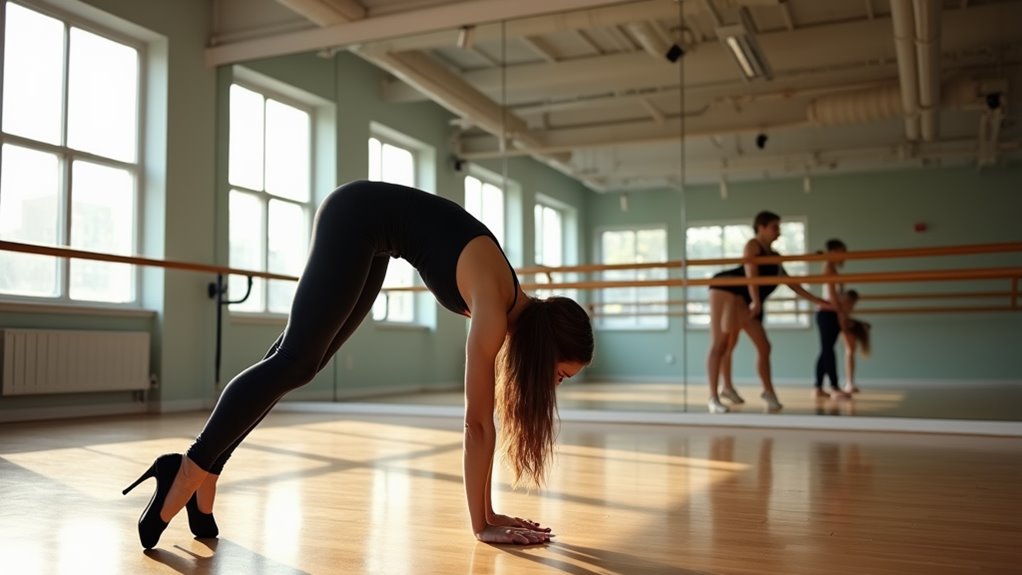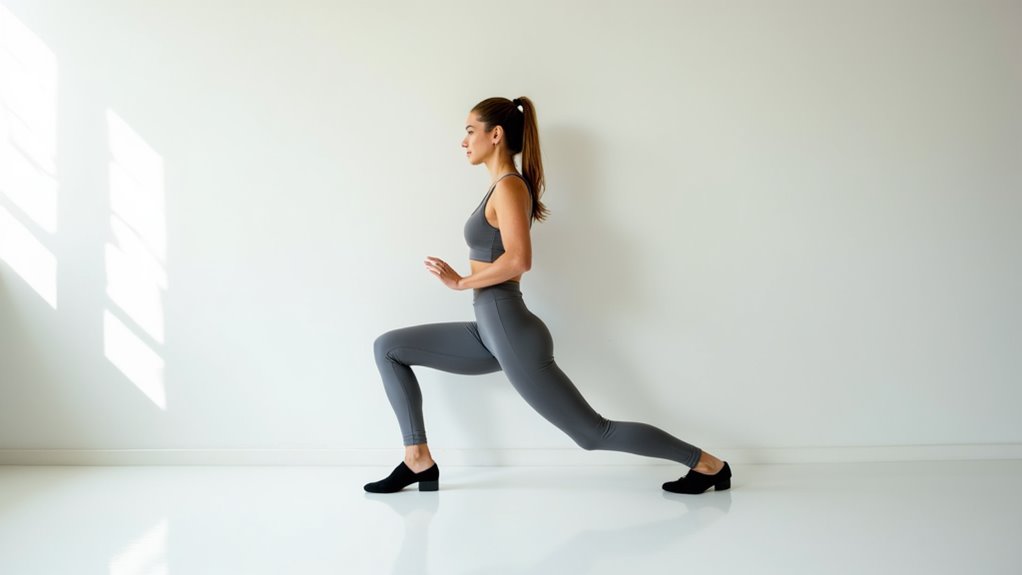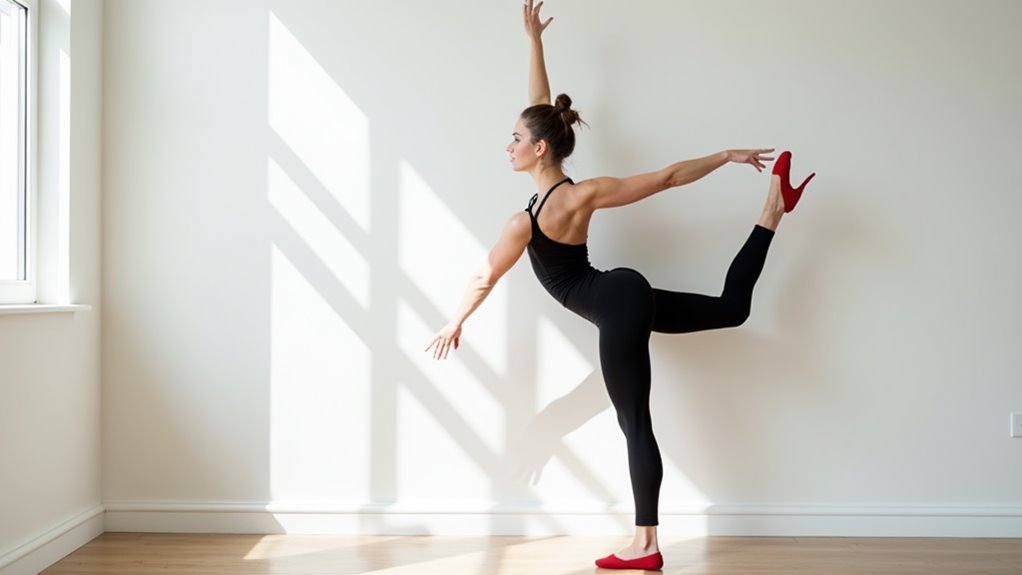There may be products. Products are independently selected by our editors. We may earn an affiliate commission from the links with no charge to you, example: as Amazon Affiliate.
We’ve identified key anatomical principles for maintaining optimal posture in stilettos through extensive biomechanical research. First, engage your core by drawing your navel toward your spine while keeping your ribcage lifted. Stack your shoulders directly above your hips, maintaining proper spinal alignment through activated upper back muscles. Practice heel-to-toe walking mechanics with shortened strides, and strengthen your ankle stability through daily resistance training. Focus on hip flexor mobility and lower back strength through targeted exercises like bridges and lunges. Master these foundational elements to unlock advanced techniques for lasting comfort in your favorite heels.
Key Takeaways
- Engage your core muscles by drawing your navel towards your spine while maintaining lifted ribcage for optimal stability in stilettos.
- Practice heel-to-toe walking technique, focusing on shorter strides and keeping your shoulders stacked above your hips.
- Strengthen ankles through resistance band exercises and single-leg balance training before gradually increasing heel heights.
- Incorporate daily stretches targeting hip flexors, calves, and feet to maintain flexibility and prevent muscle strain.
- Keep shoulders retracted and upper back engaged while maintaining vertical spinal alignment to prevent forward head posture.
Core Strength for Stiletto Success

Standing tall in stilettos requires more than just balance – it demands a robust core foundation that serves as your body’s central support system. When we engage our core muscles properly, we create a natural stability that protects our ankles and maintains a straight back while navigating in high heels. Our core acts as an internal corset, distributing weight evenly and preventing unnecessary strain on our hip flexors.
We can’t overstate the importance of building core strength through targeted exercises. By incorporating planks and Pilates into our routine, we’re developing the endurance needed for extended periods in stilettos. These exercises strengthen the deep abdominal muscles that maintain pelvic alignment, allowing us to stride confidently without compromising our lower back health. For maximum comfort during extended wear, consider pairing your core training with comfort solution pumps that provide additional support throughout your day.
Perfect Your Standing Alignment
Let’s examine the fundamental mechanics of standing alignment in stilettos, where our shoulders must stack directly above our hips to create a stable vertical line through our body’s center of gravity. We’ll maximize stability by engaging our core muscles while distributing our weight evenly between both feet, allowing our body to maintain equilibrium even on elevated heels. Our balanced weight distribution creates a strong foundation that supports proper biomechanics and reduces strain on our joints, particularly in the lower back and knees. Selecting comfort-focused heel designs can provide additional stability while maintaining elegant style.
Stack Shoulders Above Hips
Body mechanics play a crucial role in mastering stiletto wear, and proper shoulder-hip alignment forms the foundation of stable posture. When we talk about stacking shoulders above hips, we’re addressing a fundamental principle of biomechanical efficiency that directly impacts our ability to walk confidently in high heels.
Let’s focus on achieving this critical alignment: make sure your shoulders are positioned directly over your hip joints, creating a vertical line that optimizes weight distribution. We’ll want to keep your hips level while engaging the core muscles, which act as natural stabilizers for the spine. By maintaining shoulders back and down, we create a support system that prevents the common forward slouch that often occurs when wearing stilettos.
To verify proper alignment, we can use the wall check method: stand with your back against a wall, ensuring your shoulders and gluteal muscles make contact. This position helps train muscle memory for correct posture. Remember to keep your ears aligned with your shoulders, preventing the forward head position that can throw off your entire vertical alignment. When we maintain this structured position, we’re setting ourselves up for stable, comfortable movement in stilettos.
Engage Core While Standing
With shoulders properly stacked above the hips, we now turn our attention to the powerhouse of stiletto stability: core engagement. When wearing high heels, our abdominal muscles play a crucial role in maintaining proper posture and distributing weight evenly across both feet. By actively engaging our core, we create a natural support system for the spine, reducing the risk of strain and misalignment that often occurs during prolonged periods in stilettos.
To effectively engage core muscles while standing in heels:
- Draw the navel inward toward the spine, activating the deep transverse abdominis muscle
- Maintain a slight lift through the ribcage while keeping the abdominals engaged
- Focus on distributing tension evenly throughout the entire core, from the pelvic floor to the diaphragm
Regular practice of core engagement reinforces proper posture habits and builds the muscular endurance needed for comfortable heel-wearing. We’ll find that a strong, activated core not only supports our spine but also contributes to a more confident and elevated presence. This anatomical awareness becomes particularly valuable as we navigate various surfaces and situations in our stilettos.
Balance Weight Between Feet
Every stiletto wearer must master the art of balanced weight distribution to maintain optimal standing alignment. When we stand in heels, we need to consciously distribute our body weight evenly across both feet, which helps prevent unnecessary strain on our back and reduces the risk of muscle fatigue. By keeping our feet flat and aligned with our body’s center of gravity, we’re creating a stable foundation that supports proper posture.
Let’s focus on maintaining slightly bent knees while standing, as this position helps us feel better and more comfortable in our stilettos. We’ll notice an immediate difference when we engage our core muscles, as they work in conjunction with our balanced stance to support our spine. To enhance our stability and foot strength, we should practice weight-shifting exercises regularly. This involves gently transferring our weight from one foot to the other, helping our feet adapt to the demands of high heel wear.
Master the Heel-to-Toe Walk

Successfully mastering the heel-to-toe gait pattern requires precise biomechanical execution and consistent practice. We must engage our core muscles to support spinal alignment while maintaining relaxed shoulders and an upright posture. By shortening our stride length, we reduce ankle strain and create a more stable foundation for each step. The heel-to-toe walk becomes more fluid when we implement proper weight distribution and utilize supportive accessories like cushioned insoles. Consider stilettos with ventilated heel designs to enhance comfort during extended wear.
To optimize your biomechanical efficiency and look better in stilettos, follow these key principles:
- Initiate contact with the heel first, then smoothly transfer weight to the ball of the foot, maintaining continuous motion throughout the gait cycle
- Keep your spine aligned vertically while engaging core muscles, preventing anterior pelvic tilt and reducing lower back strain
- Position shoulders back and down, avoiding forward lean that can compromise your center of gravity
Balance Training Fundamentals
Let’s examine the critical balance elements that stabilize our core musculature through targeted exercises like planks and bridges, which create a solid foundation for stiletto wear. We’ll strengthen our proprioceptive awareness through single-leg balance drills, incorporating both static holds and dynamic movements to enhance ankle stability and foot control. Our heel-toe walking methods will focus on engaging the anterior tibialis and gastrocnemius muscles while maintaining proper weight distribution from the calcaneus through the metatarsals. Selecting formal heel designs with adequate cushioning and arch support will significantly improve your balance training results.
Core Stability Practice Exercises
The foundation of confident stiletto wear lies in developing robust core stability through targeted balance training. We’re going to focus on exercises that strengthen your abdominal and lower back muscles, which make you look more poised while ensuring proper spinal alignment. I’m going to share essential core stability practices that create a solid foundation for mastering stiletto movement.
Here are three key exercises for improving your core stability:
- Dynamic Plank Variations: Hold a forearm plank for 30 seconds while engaging your transverse abdominis, gradually progressing to side planks for enhanced lateral stability.
- Single-Leg Bridge Progressions: Perform bridges while extending one leg, activating your gluteal muscles and lower back stabilizers simultaneously.
- Stability Ball Core Integration: Practice seated balance exercises on a stability ball, incorporating small movements to challenge your proprioceptive system.
Single-Leg Balance Drills
Building upon our core stability foundation, we’ll focus on single-leg balance drills that specifically target the neuromuscular pathways needed for stiletto mastery. Let’s integrate a systematic approach of 30-second holds on each leg to enhance proprioception – our body’s ability to sense position and movement in space. This heightened awareness becomes crucial when navigating in elevated footwear.
We’ll want to perform these balance exercises at least three times weekly, incorporating dynamic movements like single-leg deadlifts to activate our supporting muscle groups. These movements specifically strengthen the ankle stabilizers and lower leg muscles that prevent unwanted rolling or twisting when wearing stilettos. As we practice, we’re not just standing – we’re actively engaging our core and entire kinetic chain.
Our goal is to create neural adaptations that improve stability and reduce injury risk, particularly ankle sprains that commonly occur in high heels. By maintaining proper form during these drills, we’re establishing movement patterns that translate directly to confident heel wearing. Remember to focus on quality over quantity, ensuring each balance hold fully activates the stabilizing muscles throughout our lower extremities.
Heel-Toe Walking Methods
Through proper heel-toe walking mechanics, we’re establishing foundational movement patterns crucial for mastering stiletto wear. This biomechanical approach optimizes weight distribution across the plantar surface while enhancing proprioceptive awareness during heel strike and toe-off phases. We’ll focus on developing intrinsic foot musculature while maintaining proper alignment through the kinetic chain.
To maximize the benefits of heel-toe walking, integrate these essential components into your practice:
- Initial contact should begin with the lateral heel, progressively rolling through the midfoot while engaging the arch, and finishing with controlled toe flexion for optimal push-off
- Maintain ankle stability through conscious activation of the tibialis anterior and gastrocnemius muscles, particularly during the transition between stance phases
- Practice weight transfer patterns that emphasize even distribution across the metatarsal heads, reducing excessive pressure on any single point of contact
Hip Flexor Mobility Exercises

Maintaining proper hip flexor mobility stands out as a critical component for stiletto enthusiasts seeking to protect their postural alignment. We’ve found that regular hip flexor exercises are essential for preventing the compensatory patterns that often develop from wearing high heels.
Let’s focus on specific stretches that will enhance your stiletto-wearing experience. We recommend incorporating lunges and bridge poses into your daily routine, as these movements directly target the hip flexors that become compressed during heel wear. The pigeon pose, in particular, helps release tension while promoting the flexibility needed for graceful heel walking.
When we examine the biomechanics of stiletto wear, we can’t overlook the importance of lying hip flexor stretches. These exercises help maintain optimal pelvic positioning and spinal alignment, which are crucial for preventing discomfort during extended periods in heels. By dedicating time to these mobility exercises, we’re supporting our body’s natural range of motion and building the strength necessary for stable heel walking. Remember, consistent practice of these hip mobility routines will significantly improve your ability to maintain proper posture while wearing stilettos. Pairing these exercises with foot care products can help prevent common heel-wearing discomfort and promote overall foot health.
Shoulder and Neck Positioning
We’ll optimize our shoulder and neck positioning by maintaining proper shoulder retraction aligned with our ears, which creates a stable foundation for stiletto wear. Our neck’s natural alignment directly impacts our overall posture, requiring us to engage in regular chin tucks while keeping our gaze forward to prevent strain and forward head posture. We must strengthen our upper back muscles to support these alignments, as this engagement helps prevent the common tendency to lean forward when wearing stilettos.
Alignment While Walking Tall
The vertical alignment of your shoulders and neck creates the foundation for elegant stiletto posturing. While walking in elevated heels, we must maintain our shoulders down and back, ensuring our ears align directly over them. This anatomical positioning prevents the common forward head posture that can lead to cervical strain and upper thoracic discomfort.
To optimize our alignment while walking tall, we’ll engage our core musculature, which provides essential spinal support and enhances our overall stability in stilettos. Regular posture checks against a wall help us maintain proper shoulder placement and cervical positioning, with our chin parallel to the ground to prevent the development of “text neck” syndrome.
Here’s what we need to remember for optimal alignment:
- Keep shoulders retracted and depressed, creating a stable foundation for head positioning
- Maintain chin parallel to the ground, ensuring proper cervical spine alignment
- Perform periodic shoulder rolls and neck stretches to release accumulated tension in the trapezius and cervical musculature
These biomechanical adjustments help us maintain proper posture while navigating in stilettos, reducing the risk of musculoskeletal strain and promoting efficient movement patterns.
Neck Strain Prevention Tips
Proper neck and shoulder positioning serves as a cornerstone in preventing strain while wearing stilettos. We’ll focus on maintaining optimal cervical alignment to enhance your overall posture and comfort while navigating in heels.
Let’s address the crucial aspects of neck positioning. We want your head aligned directly over your shoulders, creating a neutral spine position that minimizes unnecessary strain on your cervical vertebrae. To achieve this, we recommend implementing regular neck stretches throughout the day, particularly gentle lateral tilts, which help maintain flexibility in your sternocleidomastoid and trapezius muscles.
When checking your phone or digital devices while standing in stilettos, we must emphasize holding them at eye level. This positioning prevents the forward head posture that commonly leads to upper cervical strain. Remember to engage your core muscles while maintaining this alignment, as it creates a stable foundation that supports proper neck positioning.
Additionally, we need to focus on keeping your shoulders relaxed and positioned downward, avoiding the common tendency to hunch or elevate them. This relaxed shoulder position works synergistically with proper neck alignment to distribute tension evenly across your upper body musculature.
Building Upper Back Strength
Building resilient upper back muscles forms the foundation for maintaining optimal posture in stilettos. When we strengthen the muscles around our shoulder blades, we create a natural counterbalance to the forward-leaning tendency that high heels can create. Through consistent resistance training, we’re able to develop the muscular endurance needed for prolonged heel wear while maintaining proper spinal alignment.
Let’s focus on these essential upper back exercises that specifically target the muscles responsible for shoulder retraction and neck positioning:
- Seated rows with proper scapular engagement – Pull shoulders back and down while maintaining a neutral spine position
- Reverse flys using resistance bands – Focus on squeezing shoulder blades together at peak contraction
- Wall angels with controlled movement – Keep back flat against wall while sliding arms upward, maintaining constant contact
Daily Stretching Routines

Daily stretching provides essential relief for stiletto wearers who experience muscular adaptations from prolonged heel use. We recommend incorporating targeted stretches throughout your day to counteract the physical stress of high heels on your body’s alignment and muscle groups.
Let’s begin with hip flexors, which we can stretch effectively by lying on a bed’s edge, allowing one hip to extend downward. For upper body maintenance, we’ll focus on ‘W’ stretches against a wall, targeting the shoulders and chest muscles to prevent forward rounding. We must also address neck alignment through chin tucks, which help reset our head position and promote proper cervical spine positioning.
To maximize these stretches’ effectiveness, we’ll perform at least 10 repetitions of each movement multiple times daily. Don’t forget your calves – they’re particularly vulnerable to tightness from stiletto wear. Regular calf stretching helps maintain lower leg flexibility and supports overall postural health. This comprehensive stretching routine, when practiced consistently, helps counteract the biomechanical adaptations that occur from wearing high heels while maintaining proper muscular balance and alignment.
Foot Care Essentials
The foundation of successful stiletto wear rests on a comprehensive foot care regimen that protects and strengthens the intricate anatomical structures of our feet. By implementing targeted exercises and recovery techniques, we’re able to maintain optimal foot mechanics and reduce the biomechanical stress that stilettos place on our metatarsal region.
Let’s prioritize these essential foot care practices:
- Perform daily foot-strengthening exercises focusing on the intrinsic muscles of the arch and ankle complex, incorporating toe flexion and extension movements to enhance stability
- Utilize myofascial release techniques with a golf ball, concentrating on the plantar fascia and working through adhesions in the connective tissue to promote circulation
- Implement regular flexibility assessments of the hip flexors and quadriceps, as these muscle groups directly influence our postural alignment when wearing stilettos
We must also ensure our stilettos provide adequate support through proper fitting and cushioning. By selecting shoes with appropriate platform support and integrating cushioned insoles, we can minimize the compression forces on our metatarsal heads during prolonged wear. Consider investing in posture support heels to maintain proper alignment and reduce strain on your feet throughout the day.
Strengthening Lower Back Muscles

Strong lower back muscles serve as a critical foundation for maintaining optimal posture while navigating life in stilettos. Let’s focus on strengthening the erector spinae muscles, which run parallel to our spine and play a vital role in maintaining an upright stance when wearing heels.
We’ll start with targeted exercises that enhance spinal support. Bridges effectively engage the lower back muscles while promoting stability. By incorporating supermans into our routine, we’re activating the entire posterior chain, crucial for counterbalancing the forward tilt that stilettos create. Adding resistance training specifically targets these muscle groups, building endurance for extended heel wear.
Discover how sparkle patterns online can help you find the perfect stilettos for your workout-enhanced posture.
We can’t overlook the importance of stretching and flexibility. The cat-cow stretch helps maintain spinal mobility, while child’s pose releases tension accumulated from prolonged heel use. To create a comprehensive approach, we’ll integrate core-strengthening exercises like planks. This combination of strengthening and stretching exercises develops a robust muscular foundation that supports proper alignment and reduces injury risk. By dedicating time to these specific movements, we’re building the necessary strength to maintain elegant posture throughout our day in stilettos.
Building Ankle Stability
Building resilient ankle stability becomes paramount when conquering the world in stilettos, as these muscles form our primary defense against potential injuries and instability. We’ll strengthen our foundation through targeted exercises and progressive training techniques that enhance our neuromuscular control and proprioception.
Let’s focus on these essential stability-building components:
- Incorporate daily barefoot training sessions to activate intrinsic foot muscles and improve core stability, which directly translates to better balance when we’re wearing our favorite stilettos
- Practice ankle stabilization exercises with resistance bands, performing dorsiflexion and plantar flexion movements to strengthen the muscles surrounding our ankle joint complex
- Progress gradually through heel heights, starting with wedges or lower heels to condition our ankles while maintaining proper biomechanical alignment
We’ll complement these exercises with hip and quad flexibility routines to optimize our walking posture. By maintaining consistent practice with single-leg balance exercises and incorporating varied heel heights in our training progression, we’re building a robust foundation for confident stiletto wear while protecting our ankle integrity.
Conclusion
While we’ve delved into biomechanical mastery and anatomical precision for stiletto wear, let’s acknowledge the irony: we’re training our bodies extensively to adapt to an inherently unnatural position. Yet through core stabilization, proper pelvic alignment, and enhanced proprioception, we’re transforming these challenging accessories into extensions of our musculoskeletal system. Our bodies may protest, but we’ve equipped ourselves with the physiological tools for sustainable heel-wearing success.

